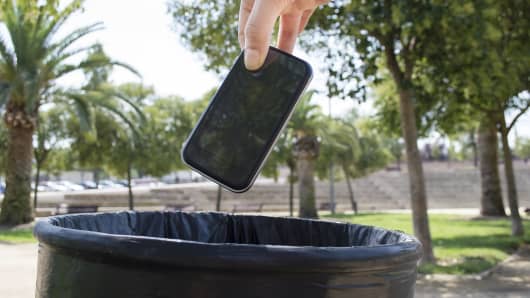The demise of the smartphone is inevitable, and necessary
Ed Fernandez, an early stage venture capitalist and a member of the CNBC-YPO Chief Executive Network
CNBC.com
Smartphones coupled with mobile services and apps (mobile ecosystems) have been the protagonists of the latest disruption tide for well over a decade. The smartphone industry accounted for more than $380 billion in revenue last year and more than 1.2 billion devices sold. IDC expects the market to grow to $451 billion annually by 2018.
Yet despite these extraordinary numbers, and despite the fact that there are an estimated 8 billion smartphones still to hit the market in the next 5 years, this industry is technically over.

Manuel Faba Ortega | Getty Images
Is the smartphone becoming extinct?
The smartphone market has reached maturity, and year-over-year growth is declining gradually, with manufacturers working with cut-throat margins and one single player monopolizing gains, seizing anestimated 93 percent of industry profits, according to investment firm Cannacord Genuity.
No need to guess—just look around you. Most likely, you have one or more Apple devices on your desk or in your pockets. When a technology goes over 50 percent penetration, the remaining audience is composed of a late majority of followers and laggards. This is the technology version of the bell curve.
In other words, with smartphone penetration well over 70 percent in more developed countries like the U.S., the saturation point was exceeded a long time ago, and the 8 billion in shipments to happen in the next 5 years are driven by emerging markets. The move to less penetrated explains why Chinese smartphone giant Xiaomi is now valued at $45 billion and expected to pursue an IPO. It also explains shorter product life cycles with little incremental innovation, and that implies less profit. If you wondered why Apple is moving quickly into wearables with the Apple Watch, this should help explain that move.
What Apple and Blackberry have in common
I've been myself involved in the mobile industry for nearly two decades (with Nokia and BlackBerry). This is what has happened:
From a software perspective, operating systems turned competition into a mobile ecosystems war, which ended in a duopoly—Google's Android capturing a majority of the volume, and Apple's iOS taking the profits.
The Apple case is ironic. The iPhone leveraged carrier distribution and the telecom services industry despite being their biggest "over the top" (OTT) services disintermediator. Services have been the ultimate disruptor, driving adoption, smartphone penetration and, ultimately, dragging sales of hardware with them. Apple is today's example;BlackBerry was a pioneer with this asymmetric model—service and user experience first—driving device preference after.
Read MoreMeet the 2015 CNBC Disruptor 50 List
In its very early days, BlackBerry didn't even have intentions to get into the hardware business. The company originally engineered the messaging service, but there were no keyboard devices to support it. BlackBerry's messaging proposition evolved into the incredibly popular mobile push email, which Wall Street embraced, ultimately buying anti-fashion qwerty devices as a necessary "accident" to have real-time email. It turned into a phenomenal hardware business for BlackBerry, fostered by carrier-driven sales of push email services embedded in their data plans.
Apple and many others follow the same pattern.
"Our heads can't continue down-staring at our screens. Something must be done to fix this, and the basic technologies to do it are already there."
Think of smartphones as the entry point to the online world. Now, wouldn't it be better, easier and more convenient to access your digital world without the constraints of a small screen?
Everything outside the realm of your smartphone's touchscreen now constitutes the domain of disruption for this industry. To put it bluntly, our heads can't continue down-staring at our screens. Something must be done to fix this, and the basic technologies to do it are already there.
Early signs can be seen even embedded in your device already.
- Siri, Microsoft's Cortana and Google Now are voice portals replacing screen access and typing. These are actually NLP (natural language processing) and A.I. technologies combined in the cloud.
- Smartphones have started talking and displaying information to TVs, projectors and now to smartwatches and wearables.
- Furthermore, we have now smart glasses and head-mounted displays (Microsoft Hololens, Magic Leap, Facebook's Oculus Rift) capable of displaying virtual images blended with our natural view of the physical world. These devices can also understand gestures.
All indicates we will be using our voice instead of typing, and we will be interacting with images well outside the limitations of today's smartphone screens.
The quest for the A.I. guardian angel
What will the next disruptive device look like?
We can guesstimate where it will be in the near term: at the intersection of smart eyeware with powerful augmented reality display and advanced voice-recognition capabilities. And couple that with wireless earbuds, as well as with other wearable apparel equipped with sensors all over our body.
But more important than any of these pieces of hardware, services in this new smart-wearable context will be delivered through new access points—voice and gestures. Access determines (and defines) hardware, but the key element gluing all this together and managing how humans interact with this new mobile computing platform is artificial intelligence.
If you Google "virtual assistant," you'll get around 18 million entries, and you'll struggle browsing results endlessly to find even the first reference to a truly artificial virtual assistant. It means we are still far from a practical experience, like in the movie "Her."
E+ | Getty Images
Whoever gets that A.I. guardian angel operating system to work seamlessly with humans will disrupt the disruptors and will take control over the wearable hardware, which ultimately will need to bend to its (proprietary) specifications or be left out of the service proposition.
Jay Samit, author of "Disrupt Yourself," said, "Disruption causes vast sums of money to flow from existing businesses and business models to new entrants."
Let's do some quick and dirty math. In the scenario we have pictured here, considering the smartphone industry represents a conservatively estimated $350 billion per year in revenue, there is potential to disrupt $1.75 trillion over the course of the next 5 years—big-time for venture capitalists.
—By Ed Fernandez, an early stage venture capitalist, start-up investor and a member of the CNBC-YPO Chief Executive Network. Fernandez is a member of the advisory board at Daedalus, a big data, predictive analytics and NLP (natural language processing) company.
@efernandez
About YPO
CNBC and YPO (Young Presidents' Organization) have formed an exclusive editorial partnership consisting of regional Chief Executive Networks in the Americas, EMEA and Asia-Pacific. These Chief Executive Networks are made up of a sample of YPO's unrivaled global network of 20,000 top executives from 120 countries who are on the front lines of the economy. The opinions of Chief Executive Networkmembers are solely their own and do not reflect the opinions of YPO as a whole or CNBC.

No comments:
Post a Comment
Note: Only a member of this blog may post a comment.